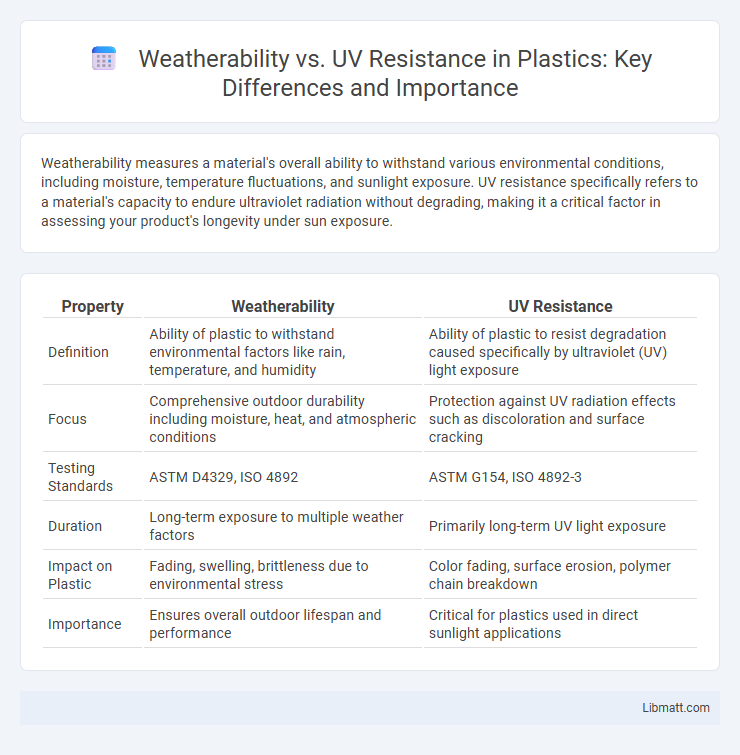Weatherability measures a material's overall ability to withstand various environmental conditions, including moisture, temperature fluctuations, and sunlight exposure. UV resistance specifically refers to a material's capacity to endure ultraviolet radiation without degrading, making it a critical factor in assessing your product's longevity under sun exposure.
Table of Comparison
| Property | Weatherability | UV Resistance |
|---|---|---|
| Definition | Ability of plastic to withstand environmental factors like rain, temperature, and humidity | Ability of plastic to resist degradation caused specifically by ultraviolet (UV) light exposure |
| Focus | Comprehensive outdoor durability including moisture, heat, and atmospheric conditions | Protection against UV radiation effects such as discoloration and surface cracking |
| Testing Standards | ASTM D4329, ISO 4892 | ASTM G154, ISO 4892-3 |
| Duration | Long-term exposure to multiple weather factors | Primarily long-term UV light exposure |
| Impact on Plastic | Fading, swelling, brittleness due to environmental stress | Color fading, surface erosion, polymer chain breakdown |
| Importance | Ensures overall outdoor lifespan and performance | Critical for plastics used in direct sunlight applications |
Understanding Weatherability and UV Resistance
Weatherability refers to a material's ability to withstand various environmental conditions, including heat, moisture, and sunlight, without significant degradation. UV resistance specifically measures a material's capacity to resist damage caused by ultraviolet radiation, which is a major factor in weathering processes. Both properties are critical for ensuring the durability and longevity of outdoor products exposed to sun and weather elements.
Key Differences Between Weatherability and UV Resistance
Weatherability measures a material's overall durability against various environmental factors such as moisture, temperature fluctuations, and sunlight, while UV resistance specifically refers to protection against ultraviolet radiation damage. Weatherability includes UV resistance but also accounts for effects like corrosion and thermal degradation, making it a broader property. Understanding the distinction is crucial for selecting materials that meet Your exposure requirements and ensure long-term performance.
Importance of Weatherability in Material Selection
Weatherability is crucial in material selection as it determines a material's ability to withstand environmental conditions such as moisture, temperature fluctuations, and sunlight exposure over time. UV resistance specifically measures how well a material endures ultraviolet radiation without degrading, which is a subset of overall weatherability factors. Prioritizing weatherability ensures longevity and performance of materials in outdoor applications, reducing maintenance costs and material failure.
The Role of UV Resistance in Outdoor Applications
UV resistance is crucial for maintaining the durability and appearance of materials exposed to sunlight in outdoor applications. It prevents degradation, discoloration, and loss of mechanical properties caused by ultraviolet radiation. Ensuring your products have high UV resistance enhances their weatherability and extends their functional lifespan.
Factors Influencing Weatherability
Weatherability is influenced by factors such as material composition, exposure duration, and environmental conditions including moisture, temperature fluctuations, and UV radiation intensity. UV resistance specifically depends on the presence of UV stabilizers, pigments, and protective coatings that absorb or reflect ultraviolet rays to prevent polymer degradation. Understanding the interaction between these factors helps optimize materials for prolonged outdoor durability and performance.
How UV Radiation Impacts Material Performance
UV radiation significantly degrades polymers by breaking chemical bonds, leading to discoloration, loss of mechanical strength, and surface cracking, which compromises overall material performance. Weatherability measures a material's ability to withstand various environmental factors, including UV exposure, temperature fluctuations, and moisture, while UV resistance specifically addresses the material's capacity to tolerate ultraviolet light without significant deterioration. Materials with high UV resistance, such as certain engineered plastics and coatings, maintain their structural integrity and aesthetic properties longer, enhancing longevity in outdoor applications.
Testing Methods for Weatherability and UV Resistance
Testing methods for weatherability and UV resistance include accelerated aging tests such as QUV chamber exposure, which simulates sunlight, temperature, and moisture to evaluate material durability. Spectrophotometric analysis measures color change and degradation, while mechanical testing assesses strength retention after UV exposure. Your material's performance data from these tests guide improvements in formulations for enhanced longevity in outdoor conditions.
Industry Standards for Weatherability and UV Protection
Industry standards for weatherability and UV protection, such as ASTM G154 and ISO 4892, provide rigorous testing protocols to evaluate material durability under simulated sunlight and environmental conditions. These standards assess factors like color retention, tensile strength, and surface degradation to ensure materials perform reliably in outdoor applications. Compliance with such standards is critical for manufacturers aiming to guarantee prolonged product lifespan and resistance to UV-induced damage.
Improving Material Performance Against Weather and UV Exposure
Enhancing weatherability and UV resistance involves selecting advanced polymers and incorporating UV stabilizers such as HALS (Hindered Amine Light Stabilizers) that protect your materials from degradation caused by sunlight, moisture, and temperature fluctuations. Surface treatments and coatings containing UV absorbers extend the lifespan by minimizing photochemical damage and maintaining mechanical properties. Optimizing these factors ensures superior durability and consistent performance of materials in harsh outdoor environments.
Choosing the Right Materials Based on Weatherability and UV Resistance
Selecting materials with superior weatherability and UV resistance is essential for ensuring longevity and performance in outdoor applications. Polymers such as fluoropolymers and acrylics exhibit high UV stability and can withstand prolonged exposure to sunlight without degrading. Engineered composites and coatings with UV stabilizers are optimal for environments requiring resistance to harsh weather conditions and ultraviolet radiation.
Weatherability vs UV Resistance Infographic

 libmatt.com
libmatt.com